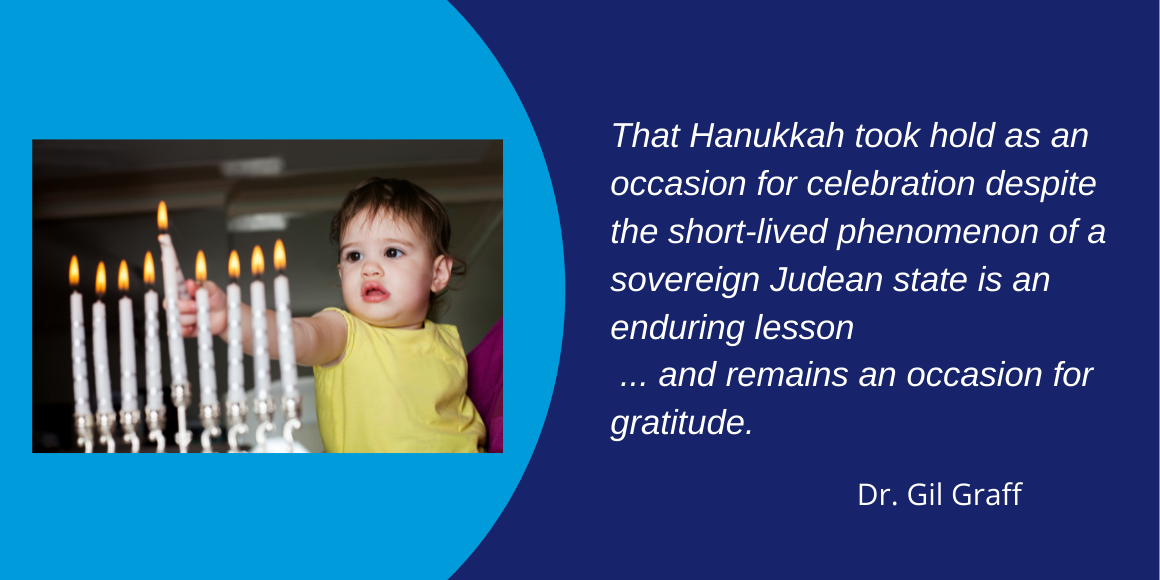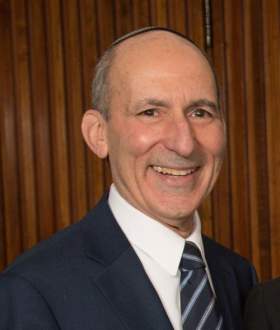
From the Maccabees to Modernity: Enduring Lessons
Though it is a minor (post-Biblical) festival in the Jewish holiday cycle, Hanukkah has, owing to its calendar proximity to Christmas, assumed a particularly prominent place in the awareness of Jews and non-Jews in the United States. Hanukkah is often associated with a struggle for religious freedom. The plot line: the Judeans fought Greeks (Hellenists) who wanted to impose an alien religion on them; the Judeans chased them away and rededicated the Temple in Jerusalem that had been defiled.
Those who have closely studied the era recognize that the prevailing circumstances were far more nuanced. There were Judeans who actively encouraged the Hellenization of Judea, and the transformation of Jerusalem to a Greek polis. Though the Greeks were ousted from control of Judea, intra-strife among Judeans characterized much of the 200 years from the establishment of an independent kingdom of Judea (under the surviving brother of Judah the Maccabee) until the destruction of the Second Temple by the Romans.
That Hanukkah took hold as an occasion for celebration despite the short-lived phenomenon of a sovereign Judean state is an enduring lesson. While it proved to be quite temporary, the opportunity of restoring the Temple and exercising sovereignty – however time-limited – was and remains an occasion for gratitude. Besides candle lighting for eight nights, Jewish liturgy includes recitation of Hallel – psalms of praise and thanksgiving – during the eight days of Hanukkah. Though we can never be certain that good times will continue, we should celebrate them in the moment and recall them with appreciation.
Despite the collapse of the Judean kingdom, Jewish life remained vibrant owing to a remarkable project of Jewish legal development and Jewish education. Notwithstanding dislocations, multiple geographic centers, and cultural differences among Jews, a sense of shared history and destiny connected Jews of differing backgrounds with one another. There were elements of unity and diversity in Jewish life throughout the many centuries from the Maccabees to modernity - nurtured by religious beliefs, communal structures, and Jewish education and experience. The question “Why Be Jewish” would not have crossed the mind of a medieval Jew; Jewishness was a reality of being.
By the 18th century, many Jews lived in lands within which notions of “inalienable rights” – without regard to individual beliefs or economic or social status – were much discussed. Writing in Berlin, in 1783, Moses Mendelssohn, a Jew known in his day as the “German Socrates,” noted, to those who called for uniformity of religion as a requirement of participation in civil society, “let us not feign agreement where diversity is evidently the plan and purpose of providence.” States should pay heed to conduct, he urged; “leave us thought and speech which the Father of us all assigned to us as an inalienable heritage and granted to us as an immutable right.”
Over time, the free exercise of religion became an accepted norm, while Western societies became increasingly secularized. For many Jews, the question “Why Be Jewish” has become quite real. For others, the question holds little interest, as they consider Jewishness to be of no particular significance, simply a matter of ancestry.
Apart from the extent of engagement of Jewish individuals with their own heritage, Jews and Judaism have been topics of fascination and comment by others for millennia. This remains the case in contemporary American society. As part of a national Shine a Light initiative to raise awareness about anti-Semitism through education, BJE has co-sponsored a bank of resource materials for educators, families, and students; we invite you to access these materials (LINK).
An enduring lesson of Jewish history from the Maccabees to modernity is that the vitality of Jewish life is inextricably intertwined with the vitality of Jewish learning. Whether during periods of turmoil or tranquility, Jewish education has sustained Jews as Jews, enabling individuals and a people to contribute uniquely to the world of which we are part. The flame of the Hanukkiah is a reminder that “Torah orah;” Jewish learning is a light, in these days as in earlier times.
Dr. Gil Graff is the Executive Director of BJE: Builders of Jewish Education

